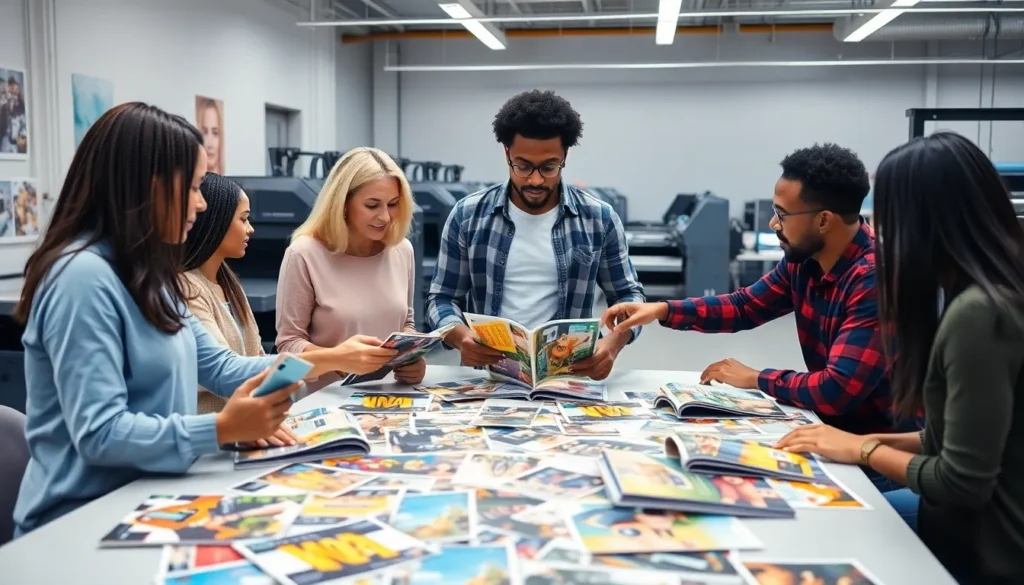In a world where digital content dominates, custom magazine printing offers a tactile experience that captivates readers. It combines creativity and quality, allowing brands and individuals to create unique publications that stand out. From glossy fashion magazines to informative niche publications, custom printing caters to diverse audiences and preferences.
The process of custom magazine printing isn’t just about putting ink on paper; it’s about telling a story. With options for size, paper quality, and binding, creators can bring their vision to life. This flexibility empowers businesses and artists to engage their audience in a way that digital formats often can’t replicate. As the demand for personalized content grows, custom magazine printing becomes an essential tool for effective communication and branding.
Table of Contents
ToggleOverview of Custom Magazine Printing
Custom magazine printing serves as a vital medium for brands and individuals aiming to create unique published works. This process not only enhances reader engagement but also provides a sensory experience that digital formats often lack.
Definition and Importance
Custom magazine printing involves producing tailored publications designed to meet specific audience needs and branding goals. It plays a crucial role in marketing and communication strategies by allowing for personalized content, which helps establish a more profound connection with readers. This format supports storytelling through visual aesthetics and curated layouts, differentiating content from competitors and fostering brand loyalty.
Key Features
- Flexibility in Size and Format: Custom magazine printing offers various sizes, from pocket-sized booklets to large coffee table publications, catering to diverse preferences and requirements.
- Diverse Paper Options: High-quality paper choices enhance the visual appeal and tactile experience, allowing for textured or glossy finishes that align with the brand’s identity.
- Variety of Binding Methods: Custom binding options, including saddle stitching, perfect binding, or spiral binding, provide durability and a polished presentation that meets the publication’s purpose.
- Vibrant Color Printing: Advanced printing technologies ensure vibrant colors and sharp images, enhancing visual storytelling and maintaining brand consistency across publications.
- Targeted Customization: Tailored content, including layouts, fonts, and images, allows businesses to align their magazines with their target audience’s preferences, enhancing engagement and impact.
Benefits of Custom Magazine Printing

Custom magazine printing offers distinct advantages that enhance brand visibility and reader engagement. These benefits include enhanced creativity in design and targeted marketing strategies.
Enhanced Creativity and Design
Custom magazine printing enables limitless creativity in design. Designers can choose unique layouts, various formats, and personalized cover designs, allowing for distinctive branding. Customization includes varied paper selections, such as glossy or matte finishes, which significantly impact the publication’s look and feel. Tailored typography and color schemes can mirror a brand’s identity, strengthening recognition. This creative control results in visually stunning magazines that captivate readers and invite them to delve into the content.
Targeted Marketing Advantages
Custom magazine printing provides targeted marketing advantages that digital formats often lack. Brands can customize content to resonate with specific audience segments. Focused themes, localized information, and relatable imagery foster deeper connections with readers. Businesses can use variable data printing to personalize individual copies, addressing preferences and demographics directly. These strategies lead to increased engagement and higher conversion rates, ensuring effective communication of brand messages.
Types of Custom Magazine Printing
Custom magazine printing includes several methods, each suited for different needs and outcomes. Two primary types of custom magazine printing are digital printing and offset printing.
Digital Printing
Digital printing utilizes digital files to produce prints directly onto various media. This method offers quick turnaround times, making it ideal for short runs and rapid production schedules. Customization occurs at the individual copy level, allowing for personalization of content. High-quality color reproduction enhances visual appeal, making vibrant images and graphics stand out. Brands often choose digital printing for its cost-effectiveness in smaller quantities and its ability to adapt designs on the fly.
Offset Printing
Offset printing is a traditional method that involves transferring ink from a plate to a rubber blanket, then onto the printing surface. This technique excels in producing large quantities of magazines with consistent quality and detail. Offset printing allows for greater control over ink saturation and color fidelity, making it suitable for intricate designs. While the initial setup cost is higher compared to digital printing, the cost per unit decreases as print volumes increase. Offset printing remains popular among businesses aiming for a polished, professional finish with wider distribution.
Choosing the Right Custom Magazine Printing Service
Selecting a custom magazine printing service requires careful consideration of various factors to ensure a successful outcome. The right choice can enhance brand identity and engage the target audience effectively.
Factors to Consider
- Printing Method: Evaluate whether digital or offset printing best suits specific needs. Digital printing offers rapid turnaround and customization for short runs, while offset printing provides consistent quality and cost-effectiveness for larger volumes.
- Quality of Materials: Investigate paper types, finishes, and inks available. High-quality materials create a professional look and feel, affecting overall reader engagement.
- Customization Options: Review available customization features. Options like size, binding, and layout play crucial roles in creating a unique publication that resonates with the audience.
- Turnaround Time: Confirm the service’s ability to meet deadlines. Timely delivery ensures that marketing campaigns align with product launches or events.
- Pricing Structure: Analyze pricing models and hidden costs. Clear price quotes help assess overall value and budget compatibility.
Reputation and Quality Assurance
- Customer Reviews: Examine client testimonials and case studies. Positive feedback often indicates a provider’s reliability and quality.
- Portfolio Accessibility: Request access to previous work. A diverse portfolio showcases a range of styles and capabilities, providing insights into the service’s strengths.
- Certification and Standards: Verify adherence to industry standards. Certification ensures the service maintains quality and practices environmentally responsible printing methods.
- Customer Service: Evaluate communication practices. Responsive and knowledgeable support enhances collaboration and addresses concerns efficiently.
Cost Considerations in Custom Magazine Printing
Cost plays a crucial role in custom magazine printing. Understanding the financial aspects helps brands make informed choices that align with their budgets and marketing goals.
Budgeting for Your Project
Budgeting for custom magazine printing involves several factors that influence total expenses. These factors include:
- Printing Method: Digital printing usually incurs lower startup costs compared to offset printing, especially for smaller runs. Offset printing becomes cost-effective for larger orders due to lower per-unit costs.
- Quantity: The total number of copies significantly impacts pricing. Higher quantities lead to reduced costs per unit.
- Paper Quality: The type of paper selected affects the budget. Premium paper options increase overall costs, while standard papers provide economical alternatives.
- Size and Format: Custom sizes or unique formats, such as square magazines, often incur additional charges.
- Binding Options: Different binding techniques, such as saddle stitching or perfect binding, vary in cost, with some offering a more polished look at higher prices.
- Design Complexity: Intricate designs and illustrations may require additional design services, affecting the overall budget.
Cost-Effective Options
Many cost-effective options exist for brands engaged in custom magazine printing. These options include:
- Short Runs: Utilizing digital printing for short runs prevents excess inventory costs and reduces waste.
- Bulk Orders: Placing bulk orders for offset printing results in lower prices per unit, making it an effective strategy for larger campaigns.
- Standard Sizes: Choosing standard magazine sizes often maintains lower production costs compared to custom dimensions.
- Paper Selection: Opting for cost-efficient paper types without compromising quality can save significant amounts while retaining visual appeal.
- Negotiate Rates: Many printing services may offer discounts for long-term partnerships or repeat orders, presenting opportunities for further savings.
- Minimalist Design: Employing a straightforward design can reduce design and printing costs, ensuring visually appealing magazines without excessive expenses.
Incorporating these budget-friendly strategies enables brands to maximize their investment while creating impactful custom magazines.
Custom magazine printing stands as a powerful medium in today’s digital landscape. Its unique ability to engage readers through tactile experiences and personalized content sets it apart from digital formats. By leveraging the flexibility in design and production methods, brands can create publications that resonate deeply with their target audience.
Choosing the right printing service plays a crucial role in maximizing the impact of these custom magazines. By focusing on quality materials and effective strategies, businesses can enhance their brand identity and foster lasting connections with readers. Ultimately, custom magazine printing not only elevates marketing efforts but also transforms how stories are told and experiences shared.









